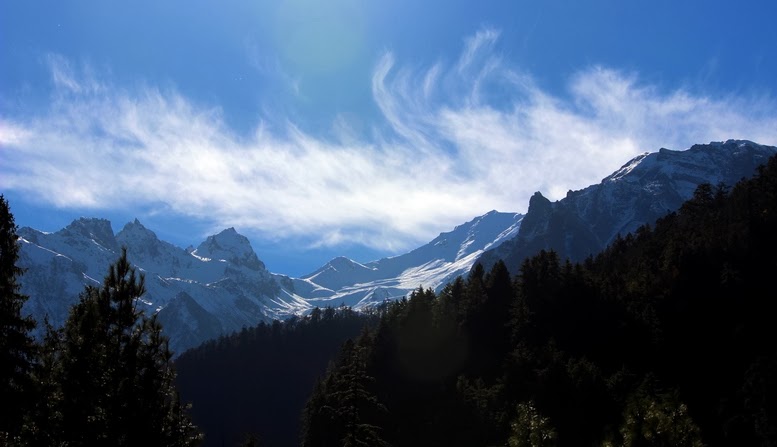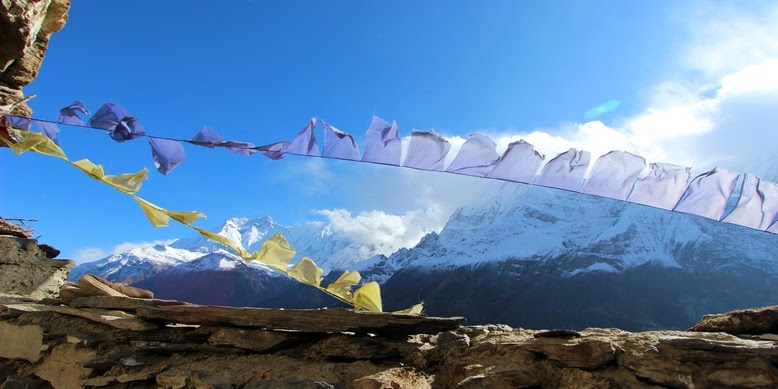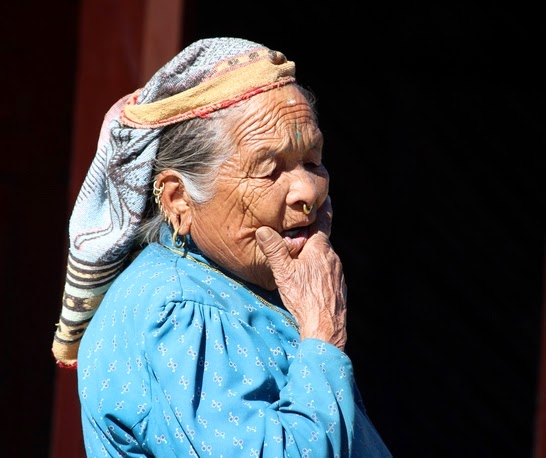
 Arriving into Kathmandu we were a bit overwhelmed by the
chaos. The noise, air pollution, and trash that littered the landscape were
shocking. We arrived to the city late at night which we weren’t too concerned
about because our hotel was to pick us up from the airport. When we woke up the
next morning we realized we were not even in the hotel that we booked, but one
of the hotel’s sister companies. The hotel had overbooked and decided to bring
us to another hotel, failing to mention this to us. It was a little
disconcerting to wake up the next morning and realize we didn’t even know where
we were (so much for my trip advisor research). We acknowledged that travel was
going to be very different in Asia than it had been in Europe.
Arriving into Kathmandu we were a bit overwhelmed by the
chaos. The noise, air pollution, and trash that littered the landscape were
shocking. We arrived to the city late at night which we weren’t too concerned
about because our hotel was to pick us up from the airport. When we woke up the
next morning we realized we were not even in the hotel that we booked, but one
of the hotel’s sister companies. The hotel had overbooked and decided to bring
us to another hotel, failing to mention this to us. It was a little
disconcerting to wake up the next morning and realize we didn’t even know where
we were (so much for my trip advisor research). We acknowledged that travel was
going to be very different in Asia than it had been in Europe.
We could not wait to get out of Kathmandu so we immediately
got our permits and TIMs pass and set out for our trek. We had decided upon
going to the Everest Region. However, when we went to the airport the next day
it was packed with trekkers laying on their bags, playing cards, and waiting
for their flights. The flight to Lukla had been delayed at least a day and a
half, which it often does due to unfavorable weather conditions. When our
flight got cancelled we decided to go to the Annapurna region instead of
waiting around in the airport for days. After a day and a half of riding in a
minibus, a bus, and then a jeep, we finally made it to Tal where we started our
trek.
Seeing the majestic Himalayas for the first time is an
experience we will never forget. The energy is palpable. The first few days of
hiking were long, but in low elevation and generally not too difficult. The
trail winded along the river through green terrain and soaring stone hillsides.
We would normally refer to these as mountains, but as our trekking companion
and quasi-guide Niran informed us, “mountain” is typically reserved by the
Nepali for the larger snow-capped monsters of which we had only caught spare
glimpses thus far.
 In addition to spectacular natural landscapes, one of the
greatest gifts of the Annapurna circuit is the ability to walk through villages
and glimpse the Nepali way of life. Farming is the primary means of survival,
followed by tourism, so most of our interactions centered around this latter
aspect of the culture. The trail winds through villages of varying size and
character. At times you feel as if you were literally walking through villagers’
homes. Traveling through Nepal is like stepping back in time, although in some
sense, you are actually stepping into the future. The year is currently 2070,
based on the lunar calendar still in use by the majority of the country. Most everything
is done by hand or with the use of the simplest tools and animal labor. Many
people have no running water or electricity and goods are transported by yaks, human
porters and the occasional jeep. Most of our food on the trail was cooked from
scratch using a wood stove, though some of the more modern kitchens used gas. The
water was often heated by solar power, which did not make for comfortable
showers :)
In addition to spectacular natural landscapes, one of the
greatest gifts of the Annapurna circuit is the ability to walk through villages
and glimpse the Nepali way of life. Farming is the primary means of survival,
followed by tourism, so most of our interactions centered around this latter
aspect of the culture. The trail winds through villages of varying size and
character. At times you feel as if you were literally walking through villagers’
homes. Traveling through Nepal is like stepping back in time, although in some
sense, you are actually stepping into the future. The year is currently 2070,
based on the lunar calendar still in use by the majority of the country. Most everything
is done by hand or with the use of the simplest tools and animal labor. Many
people have no running water or electricity and goods are transported by yaks, human
porters and the occasional jeep. Most of our food on the trail was cooked from
scratch using a wood stove, though some of the more modern kitchens used gas. The
water was often heated by solar power, which did not make for comfortable
showers :)  It is incredible to see how much the porters carry. On the
day we hiked from Pisang to Manang Tony and I were taking it particularly easy,
stopping for lots of photo opportunities and trying to let Tony’s foot blisters
heal a bit. There was a man who looked about 70 or so carrying what appeared to
be a refrigerator on his back who walked with us almost the entire day. We
barely beat him to the village ( :
It is incredible to see how much the porters carry. On the
day we hiked from Pisang to Manang Tony and I were taking it particularly easy,
stopping for lots of photo opportunities and trying to let Tony’s foot blisters
heal a bit. There was a man who looked about 70 or so carrying what appeared to
be a refrigerator on his back who walked with us almost the entire day. We
barely beat him to the village ( :
In Manang we took an acclimation day to adjust to the altitude.
On our hike from Tal to Chame we had passed a deceased porter covered with a
blanket on the side of the trail. We found out from the locals that he had been
experiencing altitude sickness and was trying to walk down to get help when he
died. Seeing the porter reinforced our understanding of the seriousness of
altitude sickness and we were determined to take every possible precaution. In
Manang we hiked to an inactive monastery at 3,990 meters to help acclimate. The
900 year old monastery consisted of only 2 or 3 rooms situated in a walled-off cave
in the mountain. We met the solitary nun who lives there (daughter of the lama
who preceded her until his health began to fail) and spent some time talking
with her about her practice and way of life. Nepal has a very rich Buddhist
culture. Prayer wheels and flags, temples, and stupas adorn the entire
Annapurna circuit. In at least one region we visited, the second son of every
family blessed with 3 sons or more was automatically ordained a monk.
 It started snowing on our way from Manang to Yak Kharka.
There was some concern that the snow would prohibit us from making it over the
Tharong Pass at the highest elevation of our trek: 5,416 meters. We were told
we wouldn’t need crampons so we didn’t have them with us, but later wished we
had for the slippery descent to the next town. It was in Yak Kharka that we
started really experiencing the cold. In the dining hall was the only source of
heat. We crowded around a wood stove heated with yak dung with trekkers from
all over the world including the U.K., Australia, China, France, and South
America. We managed to distract ourselves from the cold with a sing-a-long of
featured songs from everyone’s country. We led a not so thorough version of
American Pie.
It started snowing on our way from Manang to Yak Kharka.
There was some concern that the snow would prohibit us from making it over the
Tharong Pass at the highest elevation of our trek: 5,416 meters. We were told
we wouldn’t need crampons so we didn’t have them with us, but later wished we
had for the slippery descent to the next town. It was in Yak Kharka that we
started really experiencing the cold. In the dining hall was the only source of
heat. We crowded around a wood stove heated with yak dung with trekkers from
all over the world including the U.K., Australia, China, France, and South
America. We managed to distract ourselves from the cold with a sing-a-long of
featured songs from everyone’s country. We led a not so thorough version of
American Pie.
The next day we climbed to the higher and much colder
Tharong Base Camp. Unfortunately there was no wood stove even in the dining
hall. It got down to negative fifteen degrees Celsius that night. The porcelain
holes in the ground (aka: toilets) were covered in ice so you had to perform a
fancy balancing maneuver and pray your foot didn’t slip into the hole. Most of
the time it was just easier to make yellow snow.
As we climbed higher more and more people around us were
turning back due to altitude sickness, cold, or fear of frostbite and crossing
the pass with ice and snow. We were well aware of all the potential dangers and
we gave ourselves full permission to turn around at any point we didn’t feel
safe. The hike through the pass was difficult, very beautiful but difficult. We
did not feel well secondary to not sleeping soundly about 5,000 meters and
fighting upper respiratory infections. My headache was so bad coming down the
pass that I thought I may have had cerebral edema from the altitude. We also
spent many moments on our butts sliding down the ice and gravel on the way down.
Despite the obstacles we made it. The view from the top was incredible. Condors
soared over white-tip peaks with seemingly no destination, just enjoying their
flight.
 In Muktinah we had our first shower in six days. I’d like to
say it was wonderful, but honestly I thought I may get hypothermia from the
cold air and semi-warm water. Hiking from Muktinah to Jomsom there was a
dramatic change in the landscape as we passed from alpine to an arid desert-like
ecosystem. Niran knew a shortcut so we walked through some cow pastures and
rivers along the way. Even with the shortcut we made it just as night fell. The
rest of our crew was behind and had to hike into the night to a dimly lit
Jomsom suffering from one of their regular power outages. Everyone made it
safely and we had a candlelit dinner with our first beer in days to celebrate
safely making it through the pass and down from elevation.
In Muktinah we had our first shower in six days. I’d like to
say it was wonderful, but honestly I thought I may get hypothermia from the
cold air and semi-warm water. Hiking from Muktinah to Jomsom there was a
dramatic change in the landscape as we passed from alpine to an arid desert-like
ecosystem. Niran knew a shortcut so we walked through some cow pastures and
rivers along the way. Even with the shortcut we made it just as night fell. The
rest of our crew was behind and had to hike into the night to a dimly lit
Jomsom suffering from one of their regular power outages. Everyone made it
safely and we had a candlelit dinner with our first beer in days to celebrate
safely making it through the pass and down from elevation. From Tatoponi the ecosystem along the trail changed again as
we entered a lush green jungle with banana and orange trees, cherry blossoms,
and new species of fauna including monkeys.
From Tatoponi the ecosystem along the trail changed again as
we entered a lush green jungle with banana and orange trees, cherry blossoms,
and new species of fauna including monkeys.
After hiking for 14 days we ended
up in Birethani where we were miraculously able to find a taxi to Pokhora. It
was an old Toyota Corolla from the mid-60’s that reminded Tony of his Dad’s old
car. The buses and jeeps weren’t running because of the transportation strikes in
protest of the upcoming election on November 19th, the day we were
scheduled to fly from Kathmandu to Bangkok. There were protests with picketing
and communist flags throughout Nepal while we were there. We were told that
protesters had been putting petrol bombs in buses and jeeps whose drivers chose
to operate despite the strikes. No one had been killed, but vehicles had been
blown up, giving passengers just enough time to escape. Needless to say, we
were nervous about being on the road. Our taxi driver and Niran reassured us
that no one would bomb his taxi.
Pokhora is a very nice part of Nepal. It was almost as much of a city as Kathmandu, but with a much more relaxed, non-polluted, and fun energy. We spent a few days there regrouping and preparing for the next leg of our adventure in Thailand. From Pokhora we were able to take a police-escorted
bus back to Kathmandu. Due to the strikes, Kathmandu was actually tolerable
when we got back to the city. Without the old cars and motorbikes on the roads
you could actually breathe the air. It was like stepping back in time about 15
years to a time when the primary mode of transport was bicycle or trishaw. On the
day of our departure, election day, a trishaw driver took our bags and rode alongside
us as we jogged to the airport shuttle.
From Pokhora we were able to take a police-escorted
bus back to Kathmandu. Due to the strikes, Kathmandu was actually tolerable
when we got back to the city. Without the old cars and motorbikes on the roads
you could actually breathe the air. It was like stepping back in time about 15
years to a time when the primary mode of transport was bicycle or trishaw. On the
day of our departure, election day, a trishaw driver took our bags and rode alongside
us as we jogged to the airport shuttle.
Pokhora is a very nice part of Nepal. It was almost as much of a city as Kathmandu, but with a much more relaxed, non-polluted, and fun energy. We spent a few days there regrouping and preparing for the next leg of our adventure in Thailand.
 From Pokhora we were able to take a police-escorted
bus back to Kathmandu. Due to the strikes, Kathmandu was actually tolerable
when we got back to the city. Without the old cars and motorbikes on the roads
you could actually breathe the air. It was like stepping back in time about 15
years to a time when the primary mode of transport was bicycle or trishaw. On the
day of our departure, election day, a trishaw driver took our bags and rode alongside
us as we jogged to the airport shuttle.
From Pokhora we were able to take a police-escorted
bus back to Kathmandu. Due to the strikes, Kathmandu was actually tolerable
when we got back to the city. Without the old cars and motorbikes on the roads
you could actually breathe the air. It was like stepping back in time about 15
years to a time when the primary mode of transport was bicycle or trishaw. On the
day of our departure, election day, a trishaw driver took our bags and rode alongside
us as we jogged to the airport shuttle.
As always, you can click on a photo and scroll through larger versions than you see here.
You can read our other blog posts by clicking on the year/month links
to the right side of the page under "Blog Archive".
to the right side of the page under "Blog Archive".















































































































































































































No comments:
Post a Comment